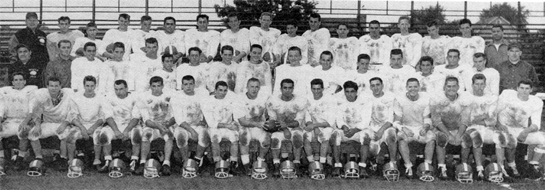The potential of the 1960 football team, Hall of Fame Coach Vic Palladino remembers vividly, was evident when the core of the team were merely freshmen. “I knew then I would have something special in a couple of years,” says Palladino. “They showed every evidence of a great talent.”
That was in 1957, and the next year the Raiders suffered through a 1-7-1 disaster. But that tough year proved to be effective seasoning, as the sophomores played and learned. The following season the Raiders turned things around, surprising everyone with a strong 6-3 mark. ” As we entered the 1960 season, then, I was pretty confident,” Palladino said. Seven of the starters had been together since the ninth grade, and as All Scholastic end George Smith recalls, “we considered ourselves a family” A large, fast, talented family at that. Palladino recalls, “I had players like Bob Cappadona, `Peppy’ Smith, Harvey Bazarian, Bob Norton, Al Verrochi, Tony Mancini, Ron Migliaccio, Tom Stanley, Larry Caruso, John Ianiello, Ed Volante. Tom Sansone and so many more standout contributors. They were dependable, in such good condition that we had an injury free year. They could run, and they could score.”
Could they ever score! The first game against Class A power Medford was never close, as the Raiders notched a 50-12 tally behind 200 yards and four touchdowns from All-Everything Cappadona. “That’s when I knew we had a team,” Smith remembers. “We knew as long as we blocked, Cappy would take care of the rest.”
That was fair to say. Cappadona ran up 1375 yards in nine games that season, with twenty-three touchdowns and a state-high 160 points, a national high school All-American pick. He had some help in the backfield, too – Mancini gained nearly 700 yards, including 140 against Belmont, and Verrochi another 400-plus, including 112 against Haverhill. Add in quarterback Migliaccio’s aerial strikes and you have the makings of a pretty potent offense. Against Newton, in week three, that offense rolled up 72 points: one paper marveled, ` `even when the heavy guns were removed the light artillery kept on scoring.” As Palladino notes, ` `the first half of the season proved they were a pretty amazing bunch of kids. They scored something close to 250 points in five games; a lot of teams take two years to do that.”
And while they were scoring the opposition wasn’t: the Watertown defense allowed just 28 points in those first five games and just 64 for the year, an average of just 7.1 per game. No Raider opponent scored more than fourteen points, and only two in double digits. It’s worth noting that when WlI made the move into Class A, its opponents included most of the big schools in Eastern Massachusetts. Indeed, these were schools much bigger than Watertown – with as many as a hundred more students trying out for football than the Raiders had. In this light the squad s achievements, on both sides of the ball, sparkle even more. The press certainly took notice. ` `What’s with this Watertown High football juggernaut? ‘ One Boston paper asked. “Speed, size, senior-itis and scoring sock, that’s what!”
Up next for the 5-0 Raiders was a strong Brookline squad. And Cappadona, despite losing ten pounds that week from an attack of the flu, came off his sickbed to carry the Raiders to victory. The fullback carried the ball for thirty-seven of WHS’s sixty-five offensive plays, netting 187 yards and two touchdowns. Those scores were all the Raiders would need as the defense settled in for a 16-8 win.
The stage was set for a showdown with undefeated Beverly, for what many recall as the game of the 1960s. With a minute left after a bruising battle, the score stood at 14-8 in favor of Beverly. The Raiders were on their own forty-three on second down.
Then Migliaecio hit Verrochi with a long strike to the Beverly ten. Cappadona ran it to the four. It was fourth down, and the Raiders were about to win. And then, a fateful call: the “21-pitch.” The fake was to Cappadona, but the pitch was to be to Verrochi. Everyone made their blocks the defense was completely fooled – Verochi had a clear shot to the end zone.
Yet in a play that is etched in the horrified memory of all who were there, the Raiders lost – by accident. The referee, too, had been fooled by the play, and ran in front of Al to watch Cappadona run. The pitch hit the ref and bounced away to the nine; Beverly took over on downs; the game was over.
The perfect season had been foiled – but the team’s greatness shone just as bright in defeat. Indeed, the next week the squad bounced back with a 36-8 drubbing of mighty Haverhill. “I can’t remember the last time any other team rolled up that many points against us,” moaned the editor of the Haverhill Gazette. After icing the cake with a solid Thanksgiving victory over an overachieving Belmont team, the 1960 squad had an 8-1 record, scoring 310 points and allowing just 64.
Perhaps the best tribute to the individual talent involved is that of the eleven starters, nine went to college on football scholarships. Perhaps the best tribute to the team as a team, though, is that of the Watertown community – which pitched in with ~7000 in private donations to send the entire squad to Miami to see the Joe Bellino-led Naval Academy play Missouri in the Orange Bowl. Even today, in a phenomenon akin to that of Ted Williams’ last at-bat, most Watertown old-timers claim to have seen every game that season. It is a season that grows in legend. But as the account above makes clear enough, the reality was pretty special in its own right.
 Watertown Cable Access Corp
Watertown Cable Access Corp
